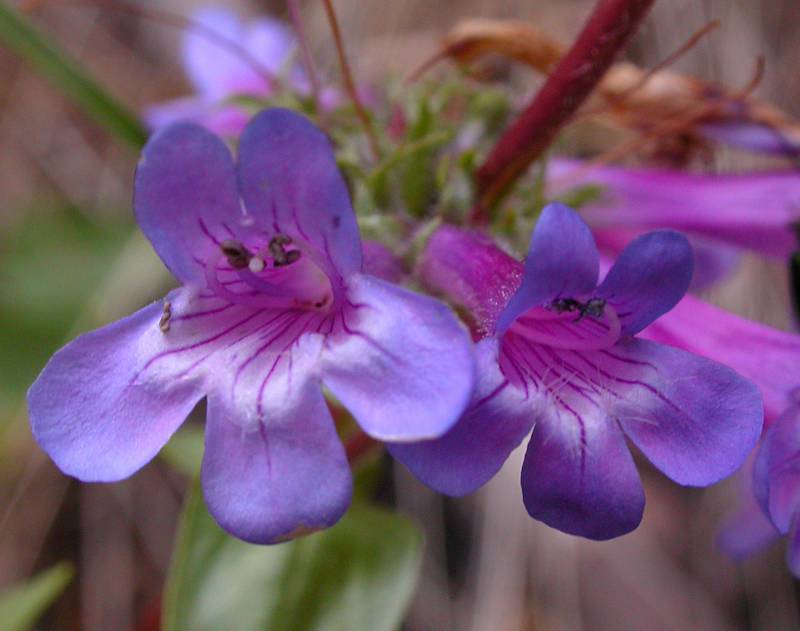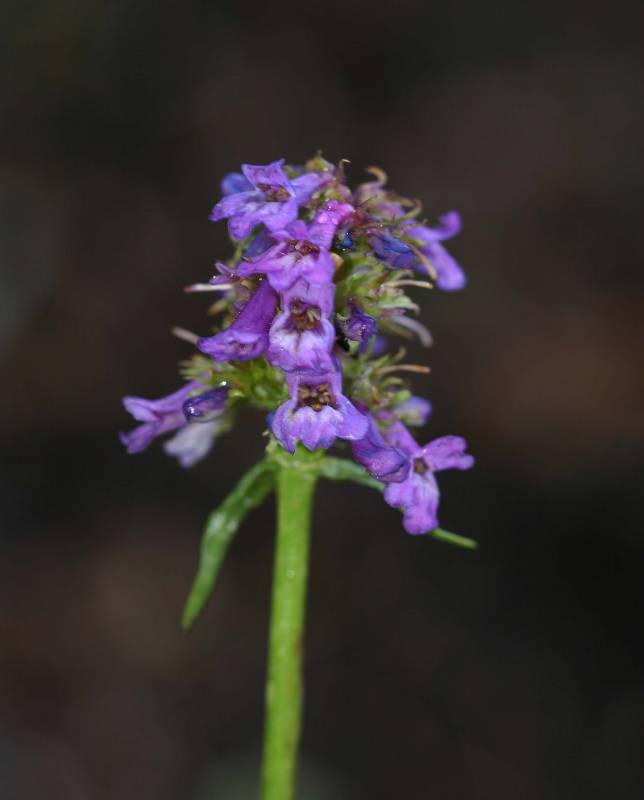|
Chelan beardtongue
|
Washington beardtongue
|
| Plants tufted from a stout, branched, and woody base, the stems 1-4 dm. tall; inflorescence always glandular-hairy, the rest of the plant varying from glandular-hairy to glabrous. |
Tufted perennials from a loose, woody rhizome, the stems 1-2.5 dm. tall, usually glabrous below the glandular-hairy inflorescence. |
Leaves opposite, usually sharply serrate, sometimes most of them entire; basal leaves well-developed, up to 10 cm. long and 2 cm. wide, the blades elliptic to ovate, equaling the petiole; cauline leaves sessile, triangular-ovate to narrowly lanceolate, smaller than the basal leaves. |
Leaves opposite, entire, the basal ones well-developed and forming rosettes, 2.5-6 cm. long and 5-18 mm. wide; cauline leaves few, sessile, often reduced. |
Inflorescence of several compact verticillasters; calyx 3-6 mm. long, the 5 segments broadly lanceolate; corolla deep blue or lavender, 11-16 mm. long, the tube slightly expanded, 2.5-5 mm. wide at the mouth, the throat paler and marked with guide lines, glandular-hairy externally, the raised portion of the lower lip bearded; pollen sacs glabrous, dehiscent throughout and becoming opposite; staminode with a bearded tip. |
Inflorescence of 1-3 dense verticillasters; calyx 4-6 mm. long, the 5 segments tapered, with scarious margins; corolla deep blue or occasionally pale yellow, glandular-hairy, 9-12 mm. long, the tube narrow, only 2-3 mm. wide at the mouth, the raised portion of the lower lip bearded; pollen sacs glabrous, sub-rotund, 0.5-0.6 mm. long, wholly dehiscent, becoming opposite; staminode bearded toward the expanded tip. |
Capsule 5-7 mm. long, glabrous. |
Capsule 4-5 mm. long |
|
|
|
|
| May-July |
June-August |
| Open, rocky places from the valleys and plains to moderate elevations in the mountains, and in the scablands in Washington. |
From open slopes and flats at moderate elevations to alpine meadows. |
Occurring east of the Cascades crest in Washington; British Columbia to Washington.
|
Occurring east of the Cascades crest, where endemic to Chelan and Okanogan in Washington.
|
| Native |
Native |
| Not of concern |
Not of concern |
P. acuminatus, P. attenuatus, P. barrettiae, P. cardwellii, P. cinereus, P. confertus, P. davidsonii, P. deustus, P. ellipticus, P. eriantherus, P. euglaucus, P. fruticosus, P. gairdneri, P. glandulosus, P. hesperius, P. lyallii, P. ovatus, P. palmeri, P. pennellianus, P. procerus, P. richardsonii, P. rupicola, P. rydbergii, P. serrulatus, P. speciosus, P. subserratus, P. triphyllus, P. venustus, P. washingtonensis, P. wilcoxii |
P. acuminatus, P. attenuatus, P. barrettiae, P. cardwellii, P. cinereus, P. confertus, P. davidsonii, P. deustus, P. ellipticus, P. eriantherus, P. euglaucus, P. fruticosus, P. gairdneri, P. glandulosus, P. hesperius, P. lyallii, P. ovatus, P. palmeri, P. pennellianus, P. procerus, P. pruinosus, P. richardsonii, P. rupicola, P. rydbergii, P. serrulatus, P. speciosus, P. subserratus, P. triphyllus, P. venustus, P. wilcoxii |
| |



